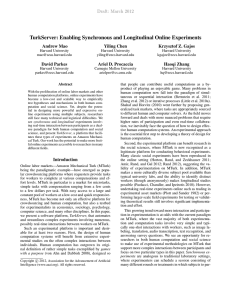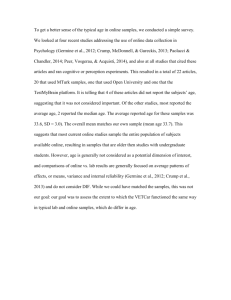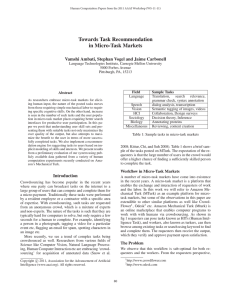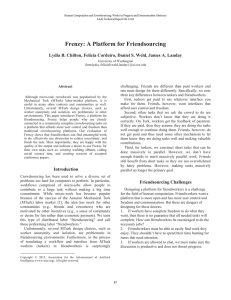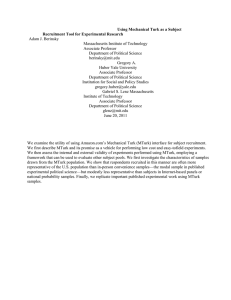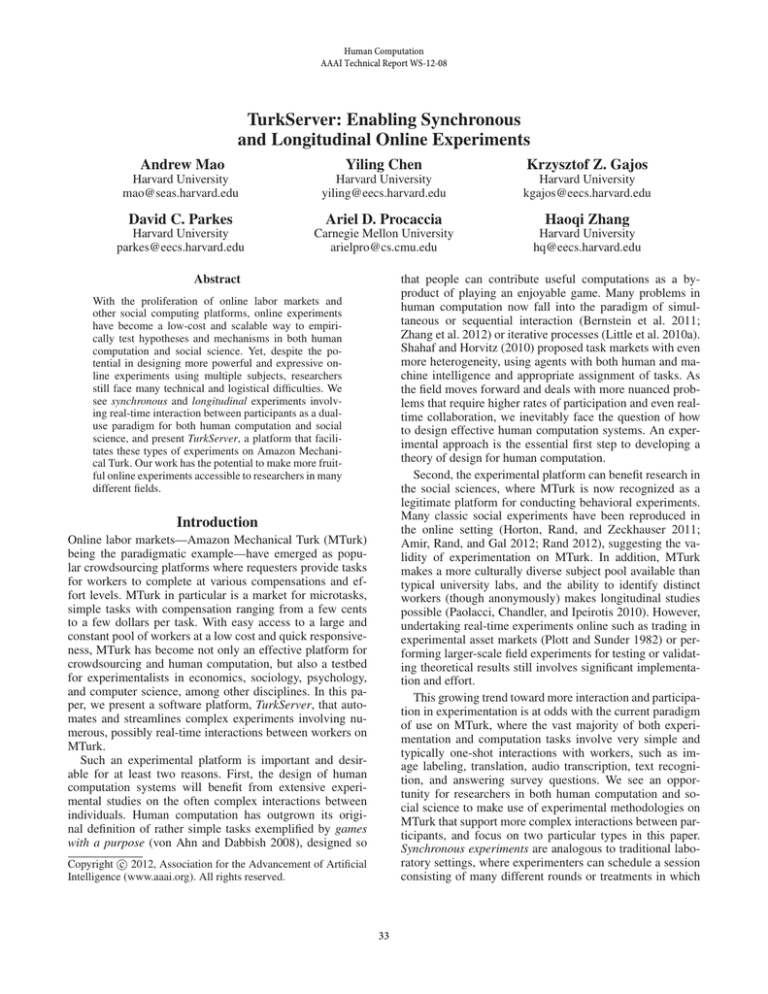
Human Computation
AAAI Technical Report WS-12-08
TurkServer: Enabling Synchronous
and Longitudinal Online Experiments
Andrew Mao
Yiling Chen
Krzysztof Z. Gajos
Harvard University
mao@seas.harvard.edu
Harvard University
yiling@eecs.harvard.edu
Harvard University
kgajos@eecs.harvard.edu
David C. Parkes
Ariel D. Procaccia
Haoqi Zhang
Harvard University
parkes@eecs.harvard.edu
Carnegie Mellon University
arielpro@cs.cmu.edu
Harvard University
hq@eecs.harvard.edu
Abstract
that people can contribute useful computations as a byproduct of playing an enjoyable game. Many problems in
human computation now fall into the paradigm of simultaneous or sequential interaction (Bernstein et al. 2011;
Zhang et al. 2012) or iterative processes (Little et al. 2010a).
Shahaf and Horvitz (2010) proposed task markets with even
more heterogeneity, using agents with both human and machine intelligence and appropriate assignment of tasks. As
the field moves forward and deals with more nuanced problems that require higher rates of participation and even realtime collaboration, we inevitably face the question of how
to design effective human computation systems. An experimental approach is the essential first step to developing a
theory of design for human computation.
Second, the experimental platform can benefit research in
the social sciences, where MTurk is now recognized as a
legitimate platform for conducting behavioral experiments.
Many classic social experiments have been reproduced in
the online setting (Horton, Rand, and Zeckhauser 2011;
Amir, Rand, and Gal 2012; Rand 2012), suggesting the validity of experimentation on MTurk. In addition, MTurk
makes a more culturally diverse subject pool available than
typical university labs, and the ability to identify distinct
workers (though anonymously) makes longitudinal studies
possible (Paolacci, Chandler, and Ipeirotis 2010). However,
undertaking real-time experiments online such as trading in
experimental asset markets (Plott and Sunder 1982) or performing larger-scale field experiments for testing or validating theoretical results still involves significant implementation and effort.
This growing trend toward more interaction and participation in experimentation is at odds with the current paradigm
of use on MTurk, where the vast majority of both experimentation and computation tasks involve very simple and
typically one-shot interactions with workers, such as image labeling, translation, audio transcription, text recognition, and answering survey questions. We see an opportunity for researchers in both human computation and social science to make use of experimental methodologies on
MTurk that support more complex interactions between participants, and focus on two particular types in this paper.
Synchronous experiments are analogous to traditional laboratory settings, where experimenters can schedule a session
consisting of many different rounds or treatments in which
With the proliferation of online labor markets and
other social computing platforms, online experiments
have become a low-cost and scalable way to empirically test hypotheses and mechanisms in both human
computation and social science. Yet, despite the potential in designing more powerful and expressive online experiments using multiple subjects, researchers
still face many technical and logistical difficulties. We
see synchronous and longitudinal experiments involving real-time interaction between participants as a dualuse paradigm for both human computation and social
science, and present TurkServer, a platform that facilitates these types of experiments on Amazon Mechanical Turk. Our work has the potential to make more fruitful online experiments accessible to researchers in many
different fields.
Introduction
Online labor markets—Amazon Mechanical Turk (MTurk)
being the paradigmatic example—have emerged as popular crowdsourcing platforms where requesters provide tasks
for workers to complete at various compensations and effort levels. MTurk in particular is a market for microtasks,
simple tasks with compensation ranging from a few cents
to a few dollars per task. With easy access to a large and
constant pool of workers at a low cost and quick responsiveness, MTurk has become not only an effective platform for
crowdsourcing and human computation, but also a testbed
for experimentalists in economics, sociology, psychology,
and computer science, among other disciplines. In this paper, we present a software platform, TurkServer, that automates and streamlines complex experiments involving numerous, possibly real-time interactions between workers on
MTurk.
Such an experimental platform is important and desirable for at least two reasons. First, the design of human
computation systems will benefit from extensive experimental studies on the often complex interactions between
individuals. Human computation has outgrown its original definition of rather simple tasks exemplified by games
with a purpose (von Ahn and Dabbish 2008), designed so
c 2012, Association for the Advancement of Artificial
Copyright Intelligence (www.aaai.org). All rights reserved.
33
this methodology, Suri and Watts (2011) conducted a networked public good experiment on MTurk, and Mason and
Watts (2012) tested the effects of network structure on collective learning by asking subjects to collaboratively drill
for oil in a shared (artificial) territory. Both experiments
were synchronous and required the interaction of multiple
subjects over several distinct rounds. These unique experiments demonstrate the feasibility of MTurk as a social research platform and suggest the possibility of conducting
even more powerful and expressive experiments on MTurk.
TurKit (Little et al. 2010b) is one of the earliest and most
popular toolkits for conducting experiments on MTurk. It is
specifically designed with iterative tasks in mind and makes
running them on MTurk both more accessible and more
powerful. However, TurKit relies on an iterative computation model and cannot handle synchronous interaction or
networked communication of individuals in experiments.
subjects participate. Longitudinal experiments allow many
subjects to interact with a central system or mechanism over
time and hence indirectly with each other. TurkServer is a
software platform that sigificantly reduces the logistical and
technical obstacles to conducting these online experiments,
making the benefits of scale, population diversity, low cost,
and fast turnaround more readily available.
Synchronous Experiments
Online synchronous experiments are most comparable to
laboratory experiments supported by software such as zTree (Fishbacher 2006). A laboratory experiment session
typically consists of a sequence of short rounds that require
frequent or real-time interaction between a set of subjects
seated in the same lab. In the online setting, however, the
physical capacity of the lab no longer constrains the number of subjects in an experiment, nor must the sessions take
place with a fixed set of subjects that interact with each other
in progressive rounds. It becomes possible to run experiments of significantly larger scale, and experiment rounds
can take place with subjects grouped as soon as they are
available, as long as this doesn’t interfere with assumptions
on how data is collected. This is well suited for the typical
behavioral research model of understanding how humans interact in different environments or mechanisms, where subjects are briefed before each session and their behavior is not
expected to vary greatly over repeated rounds.
In the rest of the paper, we outline the challenges of online experimentation and how we designed the architecture
of TurkServer to address them and provide an infrastructure
for both synchronous and longitudinal experiments. We provide a case study on using TurkServer to investigate a synchronous human computation problem, and conclude with
a discussion of promising future research directions in experimental economics. We believe that the combination of
these motivating problems and our experimental platform
will spur new empirical research using online laboratories.
Longitudinal Experiments
Challenges of Online Experimentation
A more unique direction that we envision is to conduct online longitudinal experiments, which enable the observation and analysis of long-term effects of an intervention. By
tracking a large group of users that interact asynchronously
over time, we can conduct experiments that characterize different behaviors in a setting close to the real world and empirically test hypotheses that require convergence over time.
As MTurk can identify distinct users, such experiments can
keep an “account” or “profile” for each, giving the ability to
attach information to users such as behavioral characteristics
(for studying populations), model parameters (for empirical
validation), or an endowment of assets (for testing economic
mechanisms.) Many human computation processes also fall
under the model of many users interacting over time. This
type of experiment offers the ability to use longer timescales
and more participants than a lab experiment but with more
control and direction than a field experiment, and is uniquely
suited to the online setting.
In the typical approach to MTurk experiments, many researchers use ad hoc methods; more time is usually spent
building and debugging application code than designing
experiments, and this also creates a significant roadblock
for other parties to reproduce and validate existing results.
Among other difficulties, one must write network code for
interactive experiments, keep track of different subjects, set
up appropriate experiment sessions, identify and filter noisy
or bad data, and deal with many other issues in addition to
designing the mechanism and interface of their experiments.
We see a need for a platform that allows for efficient and
practical design and data collection while reducing the obstacles to running experiments online, thus making the benefits of such experiments more readily available.
In both synchronous and longitudinal cases, the design
of an experiment has two core components from a software
point of view: a user interface defining the actions a participant can take and the information that he or she receives,
and the dynamics or central mechanism that defines updates
to participants and data based on actions taken or other exogenous events. From the software perspective, the distinction between the two types of experiments is only in how the
users are grouped together and the length of time over which
the experiment is conducted. Other capabilities of the software, such as communication, managing data, and tracking
users, differ very little. Hence, the features that are helpful
for conducting both types of experiments have a great deal
in common:
Related Work
Several researchers have promoted the idea of using MTurk
as a platform for conducting experimental behavioral research (Paolacci, Chandler, and Ipeirotis 2010; Mason and
Suri 2012). They examine worker demographics and external validity, and provide guidance for common issues researchers face when using MTurk, such as building and
tracking a panel of subjects, building reputation among
workers, providing a “waiting room” for synchronous experiments, and checking for robustness of data. Using
34
• Abstraction. A primary first step for many would-be
MTurk researchers is to figure out how to communicate
with the MTurk SOAP or REST API, usually involving
writing a nontrivial amount of code. We argue that there
should be no need to interface with the Amazon Mechanical Turk API directly, or otherwise deal with excessive
overhead for setting up experiments.
• Simplified coding. Setting up a synchronous or longitudinal experiment involves understanding the intricacies of
MTurk’s HIT posting and viewing mechanism, as well
as writing network code for the workers to communicate
with a server. Researchers are better served by focusing
on implementation of the logic and interface for the experiment itself.
• Proper Enforcement. Spammers are a natural annoyance
on MTurk, but when it comes to synchronous or longitudinal experiments, more potential issues arise: users can
participate from multiple accounts and/or log into multiple HITs at once. Experimenters may also need to enforce
limits on repeated session participation. These constraints
should all be easy to enforce.
Figure 1: Basic architecture of TurkServer. The experimenter provides the components in orange by building on
top of provided libraries, and the software handles communication between the various components and MTurk.
• User and Data Tracking. Experimenters need to track
the participation of users, both as a recruitment tool and
to evaluate performance in experiments. Results and data
of experiments need to be recorded and organized. IP addresses, geolocation features, and ease of e-mailing workers allow observation and control of user demographics.
munication, and provides skeleton classes for both synchronous and longitudinal experiments. The experimenter
extends the server-side classes with logic to define the dynamics of an experiment, builds a client-side user interface
on top of the client component, and additionally specifies
options for how users are grouped together and limits on
participation. When TurkServer begins an experiment session, the server uses the MTurk API to post an appropriate
number of HITs. As workers accept HITs, the user interface
is loaded locally and the the client initiates a bidirectional
connection to the server, using identifying metadata provided by MTurk. The TurkServer framework transparently
routes messages between the experiment logic and various
clients, while recording information about users and data
from the experiment. In this way, both the communication
between workers and the server, as well as communication
with MTurk, is abstracted, and coding is specific to the experiment itself.
When a worker connects via the client, the server will take
an action depending on the type of experiment, such as placing the worker in a virtual lobby (in synchronous experiments) or loading a worker’s account information (in longitudinal experiments.) Synchronous experiments can begin
rounds with a prespecified number of workers in the lobby,
continuing until enough data is collected. Longitudinal experiments can do away with the lobby completely, since typically each worker interacts only with the system and not directly with other workers. Moreover, the server keeps track
of the IP addresses and user IDs of workers that have accepted HITs, enforcing limits on the number of simultaneous tasks (only allowing connection from one HIT at a time,
for example) and on the total number of tasks for a session.
Various common (but annoying) situations, such as lost connections HITs being returned by users and picked up others,
are all transparently handled.
The server uses a database to store information about
• Noise Filtering. In experiments with multiple participants, workers that disconnect or stop paying attention
can have an especially great effect on data quality. The
identity and number of these users are important in deciding if results are robust or not, and should be tracked
automatically.
• Software Support. All of the above features must be deployable to the general MTurk population, and would be
impractical otherwise. A software platform should be supported by the majority of existing workers on MTurk, yet
give the experimenter the flexibility to implement necessary algorithms and features.
The TurkServer framework supports all of these commonly desired features, so that different would-be experimenters can avoid repeating the same efforts and focus on
the design of experiments themselves.
Architecture of TurkServer
TurkServer provides infrastructure for both synchronous and
longitudinal experiments, resulting in a unified platform for
conducting experiments using an online labor market. Researchers provide the dynamics and user interface that define the core experimental paradigm and problem, and TurkServer facilitates or even automates all other aspects. It integrates many methods that are inspired by the work of Mason
and Suri (2012), and adds many features of practical significance.
TurkServer consists of server and client components,
shown in Figure 1, that support bidirectional, real-time com-
35
a thorough understanding of how humans interact, compete,
coordinate, and collaborate with each other and with software agents. Among many questions that can be asked, an
initial interesting question is the following:
users and experiments, and supports collecting geolocation
data from IP addresses, as well as customizable schemata to
manage and retrieve data. The client, in addition to routing
messages between the user interface and the server, monitors mouse/keyboard actions and uses a “screen saver” style
mechanism to keep track of whether a user is actively participating in the experiment or has their attention elsewhere.
This more “active” form of attention testing is available with
real-time communication, compared to the usual test questions for non-interactive tasks such as those in Paolacci,
Chandler, and Ipeirotis (2010). When a user is observed to
be not paying attention, the client automatically warns them
that they can be subject to prespecified penalties for not
being on task, and sends the duration of inactivity to the
server. TurkServer is flexible enough for other functional
extensions, such as the more sophisticated “crowd instrumentation” logic as demonstrated in Rzeszotarski and Kittur (2011). The server also tracks when clients lose connection and records this information, as well as seamlessly reconnecting when clients return. These features ease the management of data and filtering of unwanted noise in experiments, and make it simpler to identify robust experimental
results.
The server component, implemented in Java, allows for a
great deal of implementation flexibility for the experiment
dynamics, includes a self-contained webserver, and can be
run on any system with a MySQL database. As for clients,
two types are supported: a Java applet-based library as well
as a lightweight Javascript/AJAX-based library that runs in
most modern browsers. The Java-based client is more predictable to use and debug for interfaces that are complex or
require more computation, but requires Java to be installed
for all workers. On the other hand, the Javascript client requires some more attention to browser issues, but is very
well suited for simple user interfaces and runs on just about
any system.
Together, these features allow TurkServer to be used effectively not only for synchronous and longitudinal experiments, but for general experimental work where the quality
monitoring, real-time communication, and database features
prove useful. Indeed, the authors find it to be an effective tool
for deploying many single-shot tasks on MTurk that require
no user-to-user interaction. Moreover, while a great deal of
the framework is devoted to abstracting away the MTurk
API, the other features are useful in any experimental setting, and we plan to extend TurkServer to deploy outside of
MTurk in other social computing platforms or even purposebuilt websites for experimentation.
To illustrate how TurkServer can enable a complex online
experiment, we describe our experience in using TurkServer
to study algorithmic questions on how humans can effectively coordinate in group problem solving.
Can successful algorithmic ideas from multiagent systems be adapted to effectively coordinate human computers to contribute jointly to a problem solving effort?
For example, if multiple human computers were to work
on a network of complex tasks, and there are constraints on
the solutions between such tasks, how may we support the
human computers in finding solutions that satisfy these constraints if each person is only responsible for a subset of the
tasks? In one approach, we can imagine drawing inspiration
from distributed coordination algorithms in multiagent systems to reach such a goal.
There are obvious difficulties and challenges. First, a human agent may not understand a complicated algorithm, and
additionally needs sufficient context to effectively perform
his role in the computations. In addition, the system must
convey information, through good user interface design, in a
way that is intuitive for humans to understand and process.
Finally, humans make errors, and unless such an algorithm is
somewhat robust to such errors, the performance of humans
attempting to execute the algorithm can be poor. However,
humans also have the ability to use instincts and make decisions in ways that a straightforward algorithm cannot, and a
well-designed system should allow for this potential.
Using TurkServer, we investigate this question experimentally using a a rich set of experiments with synchronicity and real-time communication—specificially, distributed
graph coloring, where agents must color the vertices of a
graph such that no two adjacent vertices share the same
color. Our focus on graph coloring is not because we expect human computation approaches to provide faster solutions than a computer. Rather, we view graph coloring
as a paradigmatic computational problem, and one from
which we hope insights will carry over to other problems.
An advantage of the graph coloring problem is that nonalgorithmic, human computation has been previously studied (Kearns, Suri, and Montfort 2006).
In the framework of synchronous experiments, a number
of subjects are asked to color a graph with the same number
of vertices. Each person can view the entire graph but controls only one vertex, and can change its color at any time.
We test various adaptations of well-known distributed constraint satisfaction algorithms (Yokoo and Hirayama 2000).
In each case, we provide normative but not fully prescriptive
advice about how to participate in the task, in the spirit of
the underlying algorithm. This approach centers on conveying algorithmic ideas in an intuitive way, while also allowing room for people to differ from the precise mechanistic
approach.
The results of experiments like this can inform the design of human computation systems, and provide insights
as to whether adaptations of user interface or instructions,
using ideas from multiagent systems, can better help human
solvers to complete a complex, collaborative, and interactive
task.
Case Study: Algorithmic Human Computation
Human computation systems can be viewed as a new type
of multiagent system, where software agents are replaced
by human computers. In the future, such systems may even
develop into hybrid systems that harness the respective abilities of software agents and human computers. This requires
36
Figure 3: View of experiments from the server’s perspective.
The left pane shows 7 users in the lobby, and the right panes
show 2 rounds (each with 15 workers) that are in progress
and several others completed.
Figure 2: Recruitment of new workers over a 65-hour period,
where TurkServer ran synchronous games for approximately
6 sessions spanning 24 total hours. No intervention was necessary except to start the server for each session, and almost
280 new workers were added to the database.
Using TurkServer
To demonstrate the capabilities of TurkServer, we recruited
workers and conducted experimental sessions for the graph
coloring problem, and describe the process in this section.
The experiments reported in this section are among the first
to require multiple workers simultaneously working on the
same task via MTurk, and are (to the best of our knowledge)
the first utilizing real-time interaction.
Before conducting our controlled experiments (referred to
as “games” for workers), we used TurkServer to coordinate
numerous example games on MTurk, setting up automated
recruitment sessions over several days (Figure 2). The purpose of these rounds was twofold: first, for us to test that
the experiment dynamics are working as expected, and second, to build a panel of experienced workers familiar with
the game. When a team of workers completed a game (either successfully or unsuccessfully), the workers were offered the choice to opt-in for messages about future sessions.
TurkServer’s database tracks the number of games played
by each worker and other characteristics that we may want
to select for a specific experiment session. Note that workers on the panel are not necessarily more successful than
the average MTurk worker; they have simply demonstrated
a willingness to play a full graph coloring game and have
some experience playing the game. Because the recruitment
sessions limit workers to few games, TurkServer recorded
almost 280 unique workers over a combined period of 24
hours.
This panel of workers was used to schedule experiment
sessions for collecting real data. We selected a set of workers from the panel using their opt-in or participation preferences, and TurkServer sent a message specifying the time
of the experiment and providing a link to the appropriate
HIT. The mechanism for these sessions is the same as the
recruitment process, except that the time was announced in
advance to obtain a large group of participants at once, and
the limit on participation in multiple rounds is relaxed.
During each scheduled session, TurkServer continually
Figure 4: Start and end times for experiments in a session of
31 rounds. Each round involved 15 participants and ended
when the graph was colored. Workers could only participate
in one round at a time.
posts HITs to MTurk. Workers who accept a HIT join a virtual lobby and wait for a game to begin. If at any point the
lobby contains enough workers, these workers are given the
option to declare themselves ready for the experiment; the
first fifteen workers to declare readiness then join a new experiment (and are removed from the lobby). Figure 3 shows
a view of this synchronous mechanism, where users can be
waiting in the lobby and multiple experiment rounds can run
at once. (Additional graphical views of the experiment and
users can be freely implemented by the experimenter.) Figure 4 shows the duration of 31 games from a particular session where about 60 users arrived from around a total of 200
contacted. Note that there were enough users for up to three
games at once.
This particular type of experiment highlights the advantage of synchronous tasks in an online labor market. One
problem that often occurs on MTurk is the prevalence of
low-quality work submitted by workers. Synchronous ses-
37
combinatorial market mechanisms (Abernethy, Chen, and
Vaughan 2012), have been designed for prediction markets to better achieve the goal of information aggregation.
New theories have been developed to understand conditions for information aggregation and impacts of trader manipulation in markets (Ostrovsky 2009; Chen et al. 2010;
Iyer, Johari, and Moallemi 2010), with very little empirical verification, except (Hanson, Oprea, and Porter 2006;
Jain and Sami 2010). The market framework has also been
generalized to eliciting answers and other contributions in
crowdsourcing (Abernethy and Frongillo 2011).
We see promise in conducting market experiments in an
online setting, in exactly the setting that they will be used—
with human traders participating in a noisy fashion connected by the Internet—yet in a controlled manner. In particular, we envision three interesting types of experiments.
First, we can imagine extending classical laboratory experiments to allow for many more possibilities. Such experiments typically have 6 to 12 participants with very specific
information structures (e.g. half of the participants know the
value of an asset with certainty and the other half have no
information), offer artificial assets, and have “markets” that
often last for 3 minutes. We can imagine a variety of settings
with more participants and more complex signal structures
to examine the robustness of classical results.
In addition, we suggest investigating recently proposed
mechanisms to compare their performance on disseminating
and aggregating information with that of the well-studied
continuous double auction. Moreover, this allows for experimentally testing and validating recent theories on information aggregation and manipulation in markets.
Finally and perhaps most interesting, we propose longitudinal prediction market experiments for real world events
(e.g. the U.S. general presidential election). There are several real prediction markets for political, economic, and
sporting events, such as Intrade and the Iowa Electronic
Markets, predicting events that will happen in the real world
with open trading for months. Using data from these markets, researchers have empirically studied prediction market
accuracy. However, it is generally impossible to view the
transactions of individual traders and study their strategic
behavior. With a longitudinal experimental market, we can
control the number of participants and track the actions of
each individual trader, allowing for a closer examination of
market dynamics and strategies of traders.
Using the infrastructure and features provided by TurkServer, we provide the community with a powerful toolbox
that enables more expressive and interactive experiments online, with features that streamline participant recruitment,
experiment implementation, and data collection. As the vast
majority of social experiments fit into the synchronous or
longitudinal paradigm that we discussed, we imagine that
TurkServer will be of great use to both the human computation and social science community. With extensive online experimental research, empirical work can more quickly
catch up with theory, and inform the state of the art in experimental social science, collective intelligence, social computing, and many other fields.
sions have two inherent safeguards against this. First, when
workers are limited to one task at a time and are paid according to the number of tasks they complete in a session, they
are incentivized to achieve the goal of the task as quickly as
possible. Second, when workers are aware that they are collaborating or competing with other humans, we notice that
the social aspect greatly increases interest compared to normal single-interaction tasks.
Nevertheless, TurkServer has features to monitor workers’ activity during an experiment and ensure that they were
actually participating. In this particular case, when a worker
does nothing (including mouse movements) for 45 seconds,
an inactivity warning replaces the game on their screen using the screen saver mechanism. Workers were warned that
being inactive for an unspecified amount of time would result in not being paid for the HIT. In all of our scheduled
sessions, we did not find that worker inactivity was a significant issue. The majority of workers never saw the warning,
and for those that did, they immediately moved their mouse.
We find that the ideal rate to pay for these experiments
is somewhat higher than the average going rate on MTurk.
Primarily, we want motivated users to earn more in an experiment session than they could doing any other task, so
that they are not only willing to participate in our sessions,
but will also exert greater effort as their pay is commensurate with the number of tasks completed. In these particular
experiments discussed, workers were paid a constant rate of
$0.20 per game, with no bonus. We were able to carry out
30 games of 15 participants each in a session lasting around
half an hour (Figure 4), at a cost of less than $100 per session.
Discussion and Future Work
TurkServer is certainly not limited to human computation
experiments, but opens many potential new and exciting directions for empirical work. We conclude with a discussion
potential experiments on asset and prediction markets that
also fall within the synchronous and longitudinal setting, and
can be very informative for both experimental economics
and collective intelligence.
Markets play a central and irreplaceable role in regional
and global economies. The ubiquity of modern financial
markets can be partially attributed to the theoretical efficiency of market mechanisms, that is, the ability of markets to quickly incorporate all information relevant to traded
assets into prices (Fama 1970). The importance of markets has led to many empirical studies in the field of experimental economics, including the seminal experimental work on dissemination and aggregation of private information of traders in a market (Plott and Sunder 1982;
Sunder 1995). However, as far as we are aware, no such realtime trading experiments have been conducted on platforms
like MTurk.
In the last decade, the idea of informational efficiency
has also motivated the development of prediction markets,
specifically designed for eliciting and aggregating information relevant to some event of interest and generating an
accurate forecast. New market mechanisms, such as logarithmic market scoring rules (Hanson 2003; 2007) and
38
Acknowledgements We are grateful to Sid Suri for invaluable discussions on online behavioral experiments. This
material is based upon work supported by NSF Grant
No. CCF-0953516 and Xerox Foundation. Haoqi Zhang is
generously funded by a NSF Graduate Research Fellowship. In addition, research was sponsored by the Army Research Laboratory and was accomplished under Cooperative Agreement Number W911NF-09-2-0053. The views
and conclusions contained in this document are those of the
authors and should not be interpreted as representing the official policies, either expressed or implied, of the Army Research Laboratory or the U.S. Government. The U.S. Government is authorized to reproduce and distribute reprints for
Government purposes notwithstanding any copyright notation here on.
Iyer, K.; Johari, R.; and Moallemi, C. C. 2010. Information aggregation in smooth markets. In Proceedings of the 11th ACM Conference on Electronic Commerce (EC), 199–205.
Jain, L., and Sami, R. 2010. Aggregation and manipulation in
prediction markets: Effects of trading mechanism and information
distribution. In Proceedings of the 10th ACM Conference on Electronic Commerce (EC), 207.
Kearns, M.; Suri, S.; and Montfort, M. 2006. An experimental
study of the coloring problem on human subject networks. Science
313:824–827.
Little, G.; Chilton, L. B.; Goldman, M.; ; and Miller, R. C. 2010a.
Exploring iterative and parallel human computation processes. In
Proceedings of the 2nd Human Computation Workshop (HCOMP).
Little, G.; Chilton, L. B.; Goldman, M.; and Miller, R. C. 2010b.
Turkit: Human computation algorithms on mechanical turk. In Proceedings of the 23rd Symposium on User Interface Software and
Technology (UIST).
Mason, W., and Suri, S. 2012. Conducting behavioral research on
Amazon’s Mechanical Turk. Behavior Research Methods 44(1):1–
23.
Mason, W., and Watts, D. J. 2012. Collective problem solving in
networks. Proceedings of the National Academy of Sciences. in
press.
Ostrovsky, M. 2009. Information aggregation in dynamic markets
with strategic traders. In Proceedings of the 10th ACM Conference
on Electronic Commerce (EC), 253.
Paolacci, G.; Chandler, J.; and Ipeirotis, P. 2010. Running experiments on amazon mechanical turk. Judgment and Decision Making
5(5):411–419.
Plott, C. R., and Sunder, S. 1982. Efficiency of experimental security markets with insider information: An application of rationalexpectations models. Journal of Political Economy 90(4):663–98.
Rand, D. G. 2012. The promise of mechanical turk: How online labor markets can help theorists run behavioral experiments. Journal
of Theoretical Biology (299):172–179.
Rzeszotarski, J. M., and Kittur, A. 2011. Instrumenting the crowd:
using implicit behavioral measures to predict task performance. In
Proceedings of the 24th Symposium on User Interface Software and
Technology (UIST).
Shahaf, D., and Horvitz, E. 2010. Generalized task markets for
human and machine computation. In Proceedings of the 24th AAAI
Conference on Artificial Intelligence, 986–993.
Sunder, S. 1995. Experimental asset markets: A survey. Princeton
NJ: Princeton University Press. chapter 6, 445–500.
Suri, S., and Watts, D. J. 2011. Cooperation and contagion
in web-based, networked public goods experiments. PLoS ONE
6(3):e16836.
von Ahn, L., and Dabbish, L. 2008. Designing games with a purpose. Communications of the ACM 51(8):58–67.
Yokoo, M., and Hirayama, K. 2000. Algorithms for distributed
constraint satisfaction: A review. Autonomous Agents and MultiAgent Systems 3:185–207.
Zhang, H.; Law, E.; Miller, R. C.; Gajos, K.; Parkes, D.; and
Horvitz, E. 2012. Human computation tasks with global constraints. In Proceedings of the 30th ACM Conference on Human
Factors in Computing Systems (CHI).
Online Resources TurkServer is currently open source1
and in active development. We encourage readers who are
interested in the software to contribute ideas or code that
can make it more useful to the community. As the API for
TurkServer is subject to change, we have not included technical details in this paper; please visit the link below for the
most current information.
References
Abernethy, J., and Frongillo, R. 2011. A collaborative mechanism for crowdsourcing prediction problems. In Proceedings of
the 25th Annual Conference on Neural Information Processing Systems (NIPS).
Abernethy, J.; Chen, Y.; and Vaughan, J. W. 2012. Efficient market making via convex optimization, and a connection to online
learning. ACM Transactions on Economics and Computation. To
Appear.
Amir, O.; Rand, D. G.; and Gal, Y. K. 2012. Economic games on
the internet: The effect of $1 stakes. PLoS ONE 7(2):e31461.
Bernstein, M. S.; Brandt, J.; Miller, R. C.; and Karger, D. R. 2011.
Crowds in two seconds: Enabling realtime crowd-powered interfaces. In Proceedings of the 24th Symposium on User Interface
Software and Technology (UIST).
Chen, Y.; Dimitrov, S.; Sami, R.; Reeves, D. M.; Pennock, D. M.;
Hanson, R. D.; Fortnow, L.; and Gonen, R. 2010. Gaming prediction markets: Equilibrium strategies with a market maker. Algorithmica 58(4):930–969.
Fama, E. 1970. Efficient capital markets: A review of theory and
empirical work. Journal of Finance 25(2):383–417.
Fishbacher, U. 2006. z-tree reference manual.
Hanson, R.; Oprea, R.; and Porter, D. 2006. Information aggregation and manipulation in an experimental market. Journal of
Economic Behavior & Organization 60(4):449–459.
Hanson, R. 2003. Combinatorial information market design. Information Systems Frontiers 5(1):105–119.
Hanson, R. 2007. Logarithmic market scoring rules for modular combinatorial information aggregation. Journal of Prediction
Markets 1(1):3–15.
Horton, J. J.; Rand, D. G.; and Zeckhauser, R. J. 2011. The online
laboratory: Conducting experiments in a real labor market. Experimental Economics (14):399–425.
1
http://turkserver.googlecode.com
39


